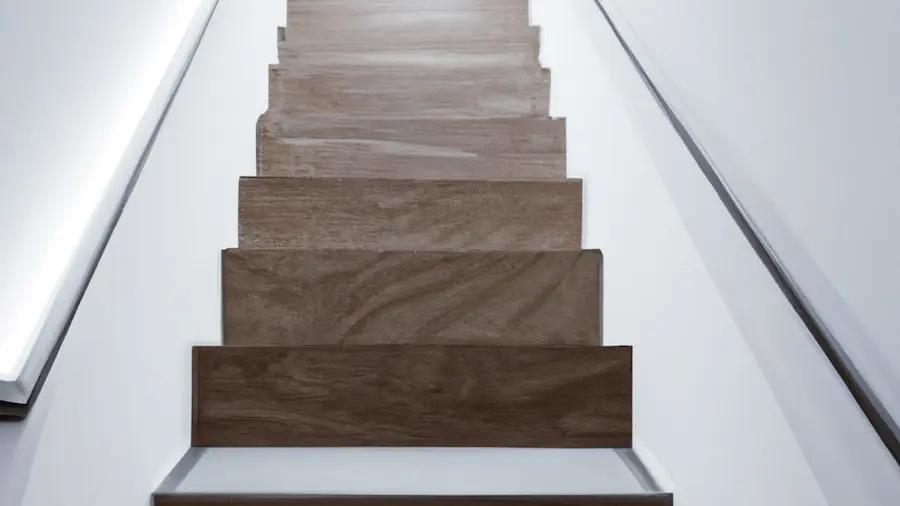~ 6 min read
Installing a Stair Runner: Carpet Installation Basics

Stair runners are a common addition to any staircase. Runners add a layer of softness that’s welcome on bare feet and helpful for those who use a stair railing. Runners come in various styles, from traditional to contemporary and even whimsical.
Carpet is one type of stair runner that’s commonly used. Although it’s the most common, it’s not the only option. Stair runners are also available in vinyl, wood, tile, and other materials.
Installing a stair runner is a DIY task that will add a little height to your staircase. The process is straightforward and requires only basic carpentry skills. It’s a relatively easy DIY home improvement project that adds character to your stairs.
What are stair runners?
Stair treads are the individual steps that make up the staircase. A stair runner is a carpet or rug that extends across the entire staircase, from top to bottom. In this case, the carpet pad and the carpet runner are the same.
The entire staircase does not have to be carpeted for it to be considered a carpeted staircase. For instance, a carpet runner can be installed for the top section of a staircase, with the treads remaining bare.
For this article, we will use the terms “carpeted staircase” and “stair runner” interchangeably.
There are many benefits to carpeting a staircase. It can make the treads safer, more comfortable, and easier to clean.
Advantages of stair runners
Wood stairs can be beautiful, but their raw edges make it hard for us to feel at ease. A rounded edge or a stair runner can help keep us safe and at ease. Adding a stair runner will also help disguise any minor flaws in the wood grain you might not like.
Adding a stair runner has many other advantages, even if your stairs are carpeted. A stair runner can help keep your carpet cleaner if you have carpeted stairs. If you have hardwood stairs, a runner can help add a bit of extra protection when you move heavy furniture items.
Stair runners are also easy to take care of. Because they often have a low pile, they are easy to vacuum. You can also easily wash, dry, and iron them if they get stained.
Disadvantages of stair runners
As we mentioned, runners on stairs have a few disadvantages. First, they do not cover the treads and risers of the stairs. This can create a strip of unfinished wood that can collect dirt, grime, and other debris. The exact measurement of the runner can also lead to a deep crease that is hard to get out. If you have hardwood stairs, this crease can mar the surface of the wood. Finally, a stair runner can get easily damaged because it is not attached to the stairs.
Even with these disadvantages, runners on stairs are a stylish and convenient way to decorate your stairs. If you think they will work for your home, take the time to install the runner carefully. This will help the runner last a long time.
How to install your stair runner
Most carpet runners are installed with staples. But staples can damage the surface of your carpet. On stairs that have hardwood or laminate flooring, nails can also damage the surface.
The outer edges of a carpet runner do not need to be finished because they will not show. If you run the carpet to the edge of the stair, you will have to deal with the exposed edges of the runner.
You can use double-sided carpet tape to secure the runner to the stair rods to conceal the edges. Put a few pieces of tape on each stair rod and attach them to the runner’s edges.
It is essential to leave a few inches of the runner unsecured. This will allow you to lift the runner and move it back into position if you need to.
Tips for buying and installing a stair runner
You can handle this job even if you have never installed a carpet runner before. It is a tiny area, but you won’t need to install tack strips or staples along the sides of the rows. You also won’t need a full-size carpet runner for steps. A row of staples can secure a narrow strip of carpet just wide enough to span the riser.
You can also use carpet rods to secure a runner on stairs. These rods install over the riser below and above the carpet on the step above the riser. They are secured in place with screws.
You may also be able to install carpet on stairs without using a runner at all. For a carpet that doesn’t move often, you can glue the carpet to the steps, then use a heavy weight to hold it in place as it dries.
For a carpet that moves often, a runner is the best option. But you may need a little extra foot to reach the riser below. For carpet that moves frequently, you may need to regularly move the runner back to the riser below and then move it forward again.
Installing a stair runner is a great way to add style and comfort to your home. Carpet installation is a relatively straightforward process, but there are a few things to keep in mind to ensure a smooth installation. First, measure your stairs to ensure that your runner will fit properly. Second, when installing the runner, use a carpet adhesive and tuck the runner’s edges under the lip of each step to secure it in place. With a bit of time and effort, you can easily install a stair runner and enjoy its benefits to your home.
Related Reading: